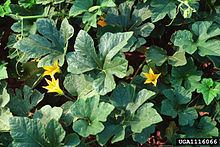Kingdom Plantae Clade Eudicots Order Cucurbitales Rank Species | Clade Angiosperms Clade Rosids Family Cucurbitaceae | |
 | ||
Similar Cucurbita okeechobeensis, Cucurbita andreana, Cucurbita ecuadorensis, Cucurbita digitata, Cucurbita californica | ||
Cucurbita texana, also known as Cucurbita pepo subsp. texana and Texas gourd, is a mesophyte plant species of the genus Cucurbita. It is native to Texas, primarily the southeastern region. It is found only in the wild. It is possibly a progenitor and close relative of the domesticated species Cucurbita pepo, though it and wild C. pepo are native to different areas. Cucurbita fraterna is also closely related. It was first collected 1835 by J. L. Berlandier in southern Texas. It was formally described as Tristemon texanus by George Heinrich Adolf Scheele in 1848 and transferred to the genus Cucurbita by Asa Gray in 1850.
Its usual habitat is in or near sandy riverbeds.
The debate about the relationship of C. pepo, C. fraterna, and C. texana has been going on since at least 1857. C. pepo has more similarities to C. fraterna than it does to C. texana which is also claimed to be an ancestor of C. pepo. The isozymes of C. pepo and C. fraterna are very similar. C. fraterna shares alleles with C. pepo at all 25 studied loci, indicating C. fraterna is the nearest relative of C. pepo. C. pepo is most likely an early domesticated form of C. fraterna. It crosses well with both C. pepo and C. texana. C. pepo could be a compilospecies of C. fraterna and C. texana, which appear to be two species that were originally separate. Based on genetic allele analysis, there are two distinct groups within C. pepo: pumpkin, calabaza, criolla, and marrow squash are in one, and ornamental gourds, crookneck squash, acorn squash, pattypan squash, and a few others are in the other. C. fraterna is genetically closer to the first group and C. texana is genetically closer to the second group. No obvious constraints to gene flow between C. texana and C. pepo cultivars have been observed, regardless of which was the male or female parent; there is a distinct lack of reproductive isolation. However, the early origins of C. pepo in Mexico are well documented.
